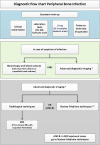Consensus document for the diagnosis of peripheral bone infection in adults: a joint paper by the EANM, EBJIS, and ESR (with ESCMID endorsement)
- PMID: 30675635
- PMCID: PMC6450853
- DOI: 10.1007/s00259-019-4262-x
Consensus document for the diagnosis of peripheral bone infection in adults: a joint paper by the EANM, EBJIS, and ESR (with ESCMID endorsement)
Abstract
Introduction: In adults with a suspicion of peripheral bone infection, evidence-based guidelines in choosing the most accurate diagnostic strategy are lacking.
Aim and methods: To provide an evidence-based, multidisciplinary consensus document on the diagnostic management of adult patients with PBIs, we performed a systematic review of relevant infectious, microbiological, orthopedic, radiological, and nuclear medicine literature. Delegates from four European societies (European Bone and Joint Infection Society, European Society of Microbiology and Infectious Diseases, European Society or Radiology, and European Association of Nuclear Medicine) defined clinical questions to be addressed, thoroughly reviewed the literature pertinent to each of the questions, and thereby evaluated the diagnostic accuracy of each diagnostic technique. Inclusion of the papers per statement was based on a PICO (Population/problem - Intervention/indicator - Comparator - Outcome) question following the strategy reported by the Oxford Centre for Evidence-based Medicine. For each statement, the level of evidence was graded according to the 2011 review of the Oxford Centre for Evidence-based Medicine. All approved statements were addressed taking into consideration the available diagnostic procedures, patient acceptance, tolerability, complications, and costs in Europe. Finally, a commonly agreed-upon diagnostic flowchart was developed.
Keywords: Diagnosis of infection; Guideline; Imaging; Osteitis; Osteomyelitis; Peripheral bone infection.
Conflict of interest statement
The authors declare that they have no conflicts of interest.
Figures


References
-
- Mader JT, Ortiz M, Calhoun JH. Update on the diagnosis and management of osteomyelitis. Clin Podiatr Med Surg. 1996;13(4):701–724. - PubMed
MeSH terms
Substances
LinkOut - more resources
Full Text Sources
Other Literature Sources
Miscellaneous

